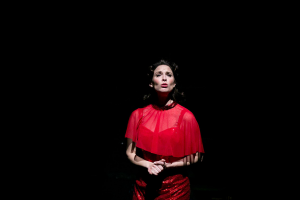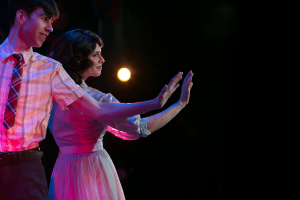Bryant Gets Lost in Diversionary’s Admirable ‘Loneliest Girl’ Premiere
What do you do when you are the third oldest LGBT+ theatre company in the U.S. and you have the opportunity to put on the world premiere of a musical about one of the major villains of the struggle for equality? You do the right thing, of course, and make sure that the show you’re mounting isn’t a screed. Only, you find that in doing so you have a story that’s lost some of its zip.
Under the leadership of Matt M. Morrow, Diversionary Theatre has gifted San Diego with sharp and complex productions and has broken the mold for what might be thought of as “gay” theatre. Its current production, Julia Meinwald and Gordon Leary’s The Loneliest Girl in the World aims even higher – and in many ways gets there.
Objectively, Anita Bryant was a loser. She lost the title of Miss America to Mary Ann Mobley and struggled to achieve the fame and fortune that she craved. She aimed to have a career as a singer and ended up mostly as a spokesmodel. She achieved notoriety by virtuously spreading hate.
Still, she was widely admired until she had the wind knocked out of her sails when Thom Higgins, a gay activist from Minnesota, walked up to her and put a pie in her face.
Ms. Meinwald and Mr. Leary’s musical draws Ms. Bryant’s character from the historical record but imagines Mr. Higgins’ character, who they label “Tommy.” Their first act begins with Ms. Bryant’s loss of the Miss America title and outlines how her career and personal life developed. Tommy is portrayed as a young fan who writes to Ms. Bryant and receives an encouraging “thank you” note from her in return. As the musical progresses, Tommy discovers his sexuality, and the importance of the two leads reverses.
While such a reversal is potentially interesting, it proves to be problematic. Tommy’s character advances, both dramatically and musically, and Anita’s character stagnates in both areas. As a result, the second act crawls its way toward its foreshadowed pie-in-the-face climax.
Act 2 problems are common in musicals: Diversionary’s previous world premiere, The Boy Who Danced on Air, had them, too. The official first production is typically followed by more development, and I think that Ms. Meinwald and Mr. Leary will be able to follow up with what they’ve learned from the Diversionary run (which has been extended).
There’s no problem with the physical production, though. While shoehorning the show’s requirements into Diversionary’s limited space clearly presented challenges, Mr. Morrow and his team have turned every challenge into a production asset. In large measure, that’s because he has assembled a first-rate cast and creative team. Robin Sanford Roberts has designed a clever unit set that can be augmented with props (designed by Bonnie Durben) as needed. Christina J. Martin provided the area-focused lighting design, while Matt Lescault-Wood’s sound design balances singers and musicians expertly. Elisa Benzoni’s costume designs are both stylish and humorous, as needed, supplanted nicely by Peter Herman’s wig design. Patrick Marion’s musical direction gracefully highlights the tuneful score, and Stephen Brotebeck’s pleasant choreography never overwhelms.
The cast, too, sparkles, led by Allison Spratt Pearce’s nuanced portrayal of Anita Bryant and Sam Heldt’s turn as Tommy. Lauren King Thompson makes an excellent foil for Anita as Miss America winner Mary Ann Mobley, while Marci Anne Wuebben balances the emotional tenor as Anita’s sister, Kay. Steve Gouveia plays men in Anita’s life, none particularly sympathetic, while Shaun Tuazon delights with his variety of (mostly gay) characters.
The production’s program lists the run time as two hours and ten minutes, including a fifteen minute intermission. Opening night, the run time was closer to two hours and forty five minutes. At either length, it’s still worth seeing this ambitious production.
[box]Runs through July 1 at Diversionary’s mainstage space in University Heights. Showtimes are Thursdays at 7pm, Fridays and Saturdays at 8pm, and Sundays at 2pm. Parking is on neighborhood streets and can be difficult. Allow extra time to arrive at the venue. This review was based on the opening night performance, Saturday, June 2.
DOWNLOAD CAST AND CREDITS[/box]

In addition to reviewing theatre for San Diego Story, Bill also reviews for TalkinBroadway.com. He is a member of the San Diego Theatre Critics Circle and the American Theatre Critics Association. Bill is an emeritus professor in the School of Journalism and Media Studies at San Diego State University.




